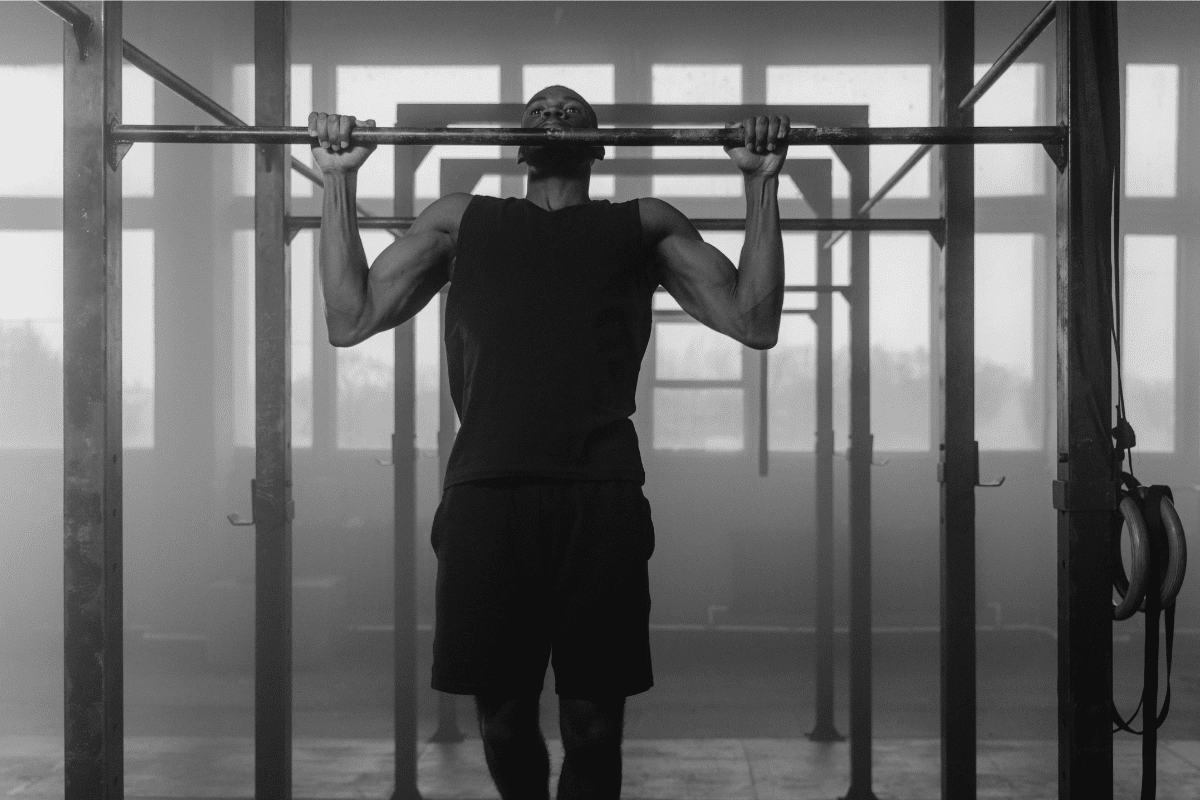Pull-ups (How To, Progressions, Muscles Worked)
One of the most basic but also probably one of the most important exercises a person can master is the pull-up. The pull-up is used by many strength and conditioning specialists, physical therapists, sports medicine professionals, and even the military to gauge upper body strength and strength endurance.
In this guide, I will be going over how to do a proper pull-up, coaching points, common mistakes, and some variations, alternatives, and modifications if you happen to need them.
How To Do Pull-Ups
Equipment Needed
- Pull Up Bar (Either as part of a rack or a wall-mounted bar)
- Weight belt (For weighted variations)
- For modification purposes:
- Lifting Band (To assist in completing the pull-up or doing more repetitions with full range of motion).
- Lifting partner (To assist in getting your chin over the bar)
- Bench (To help reach the bar if it’s too high)
Muscles Worked
- Lats
- Upper back
- Biceps
- Abdominal and lower back muscles (Stabilizers in almost all movements)
Step-by-Step Instruction
- Approach the pull-up bar and grab the bar with a pronated grip (palms facing away).
- Use a bench to get to the bar if it is too high.
- Later in the article, I will talk about variations, alternatives, and modifications where the supinated (palms facing in) grip will be discussed.
- Squeeze the bar and engage the core muscles and do not cross your legs.
- Engage the upper back and pull up until your chin is over the bar.
- Pause for 1 second with your chin over the bar.
- Slowly lower yourself back to the starting position.
Coaching Points
Take your time and master the pull-up. The benefits of doing sound pull-ups will pay dividends for your shoulder health and the potential to maximize your upper body strength.
I would highly recommend this movement to any lifter or athlete. It provides all the benefits of an upper-body pulling movement with little to no risk.
Common Mistakes
By far the biggest mistake I see in the pull-up is lifters not using a full range of motion. Hang all the way down and maintain great tension through the shoulders and abdomen (DO NOT JUST HANG IN THE BOTTOM). Pull all the way up and do not whip your head so that your chin barely makes it over the bar.
As with any exercise, do not sacrifice form for the completion or more weight.
Another mistake is lifters go too fast with their pull-ups. Pull-ups are commonly programmed for strength and hypertrophy. This means time under tension is key. Take them slow and perfect the movement to yield maximal results.
Benefits of Pull-Ups
Here are some of the key advantages of incorporating Pull-Ups into your training program:
- Pull-Ups primarily target your lats, biceps, and upper back, effectively building strength in these muscle groups.
- When performed correctly, Pull-Ups also engage your core muscles, which can aid in improving stability and posture.
- All you really need is a sturdy pull-up bar, making it a convenient option for those without access to a fully-equipped gym.
- Holding onto the bar challenges your grip strength, which can be beneficial for other lifting exercises and sports that require a strong grip.
Pull Up Modifications
For many, pull-ups are an advanced movement. Few people can just start doing 5 or more perfect pull-ups. (Emphasis on the word perfect).
Here are some modifications to the pull-up that will help you progress and achieve successful full-range motion pull-ups with patience and persistence.
Band Assisted Pull-Ups
Loop a band to the top of the lifting rack or pull-up bar. Place your knee or foot in the band. Execute the pull-up with perfect form. Use a band that allows you to complete 3-8 pull-ups with perfect form. If you can do more than 8 with this band, use a thinner band.
As you progress with your band-assisted, always consider doing pull-ups without assistance. Track your progress and push yourself to perform those pull-ups without help.
Partner Assisted Concentric Followed by Eccentric Pull-Up
Have a partner assist you in reaching the top of the pull-up repetition. Then slowly lower yourself down to the start. This is a great variation for novice lifters who need to focus on time under tension, improve grip and core strength, and develop those posterior chain muscles that we know need to be strong.
Isometric Pull-Up Holds
Get to the top of the rep by jumping up or have a partner assist you. Then hold an isometric position with your chin over the bar. Do not rest your chin on the bar. Squeeze that position as hard as you can. The duration of the rep should be programmed and progressed based on athlete readiness.
Pull Up Variations
The pull-up has some great variations that can be utilized based on athletic readiness, training needs, and sport specificity.
Chin-Ups

Flip your grip and crush your chin-ups. The Chin-up is where you have a supinated grip (palms facing in). This is generally considered an easier variation and can be used prior to the pull-up in a lifting progression and program. The chin-up also engages more biceps.
Wide Grip Pull-Ups
Execute your pull-ups with a wider grip. This will highly engage the lats and upper back. This is a more advanced movement for lifters. I would not recommend this movement until the regular chin-up and pull-up movements are dialed in 8+ perfect reps can be completed.
Weighted Pull-Ups
Grab your weight belt and overload your pull-ups. Weighted pull-ups are one of the best variations a lifter can make to their training programs. Once regular pull-ups are perfected, progressive overload must be challenged. I would highly recommend this lift for any lifter who is ready to challenge their upper body strength.
Pull-Up Alternatives
If a lifter is not ready for pull-ups, don’t worry. There are tons of movements that train the upper body for pulling.
Need more options? Here are my 10 favorite Pull-up alternatives and variations.
Inverted Rows
Inverted Rows are another bodyweight back exercise that is not to be underestimated.
Set your barbell at bench press height. Take a pronated or supinated grip based on your needs. Extend your legs, engages the core, and pull yourself up the bar. Lock in the reps and slowly lower yourself back down. This is a fantastic movement for lifters to develop those posterior chain muscles.
Not only are they a great progression to get you on the path to being able to do pull-ups, but Inverted Rows would also be my recommended substitution if you have a rack but no pull-up bar.
Inverted Row From Rings

A simple progression for inverted rows is to use the ring implement. This allows for more movement at the shoulder. You can start with a pronated grip and as you pull, twist your hand. This is a great movement for rotational/overhead athletes like pitchers who need to build their external movers of the shoulder.
Also, if you don’t have a rack you can get creative with how to hang rings at home.
Lat Pulldown Machine
I do not often recommend machines but in this case, the lat pull-down machine is worth mentioning. If a lifter has a lower-body injury, the lat pull-down is a great option for continuing training while the lower half is being rehabilitated.
This is also a great option for novice and veteran lifters looking to add extra volume at the end of a session.

Online Strength Programs
- 1-on-1 Online Coaching
- Sports Performance Programs for Football, Basketball, Soccer & More
- Programs for Former Athletes (Legends) Who Still Want to Train Like Athletes
- Programs for Adults Who Want to Get Healthy (and look great at the beach!)
- Use Code “HB10” to Get 10% Off Today
More Info and Links
Looking for some more great exercises to increase your upper body strength? Head over to our exercise library to find step-by-step exercises to help you get stronger. All for free.

